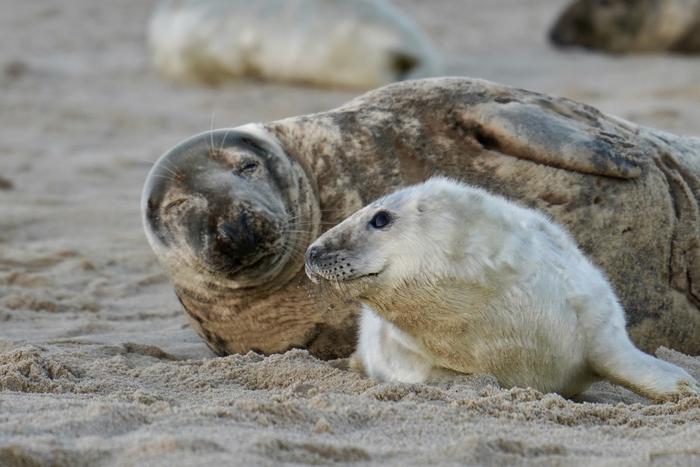In the remote and harsh environments where marine mammals such as seals thrive, evolutionary adaptations have shaped reproductive strategies that are as remarkable as they are instructive. New research led by Michelle Shero, an assistant scientist at the Woods Hole Oceanographic Institution (WHOI), delves into the extraordinary reproductive biology of seals, uncovering mechanisms that may hold transformative potential for addressing human reproductive health challenges. Published recently in Fertility and Sterility Reports, Shero’s study explores how the life history traits of marine mammals could inspire innovative biomedical solutions.
Seals endure prolonged fasting periods during lactation, losing nearly a third of their body mass while nourishing their pups. This ability to sustain themselves metabolically under severe energy constraints stands in stark contrast to human physiology and offers a unique window into managing metabolic demands during reproduction. Shero’s comprehensive review connects these physiological extremes to possible pathways for novel therapeutic strategies, particularly concerning gestational metabolic disorders.
One of the most striking physiological adaptations in seals lies in their management of insulin resistance. In humans, insulin resistance often heralds pathological conditions like gestational diabetes, which poses significant risks for both mother and fetus, including the possibility of fetal macrosomia and complications during delivery. However, seals appear to possess a fundamentally different approach. Their insulin resistance supports the mobilization and utilization of fats during their fasting states without compromising muscle mass or inducing diabetes-like pathologies. This nuanced metabolic control could redefine how insulin dynamics are understood in pregnancy, potentially opening avenues for early interventions in human maternal-fetal medicine.
Oxygen management strategies in seals provide another extraordinary lesson for biomedical science. Marine mammals routinely undertake deep dives lasting up to two hours, necessitating an extreme tolerance to hypoxia. Unlike humans, whose fetuses can suffer irreversible damage from oxygen deprivation during birth, seal fetuses develop in utero under similarly low oxygen conditions repeatedly. Shero explains that seals store significantly higher levels of oxygen in their blood and muscles compared to terrestrial mammals, and they orchestrate oxygen distribution carefully to prioritize vital organs like the brain and heart during dives while temporarily restricting supply to peripheral tissues. This refined physiological orchestration may yield insights into preventing birth-related hypoxic injury in humans.
Moreover, seals exhibit a reproductive phenomenon known as embryonic diapause — the capacity to suspend embryonic development until environmental and energetic conditions are favorable for parturition. This evolutionary strategy ensures offspring survival in unpredictable environments such as the frigid and nutrient-variable habitats of the North Atlantic. Shero suggests that understanding the molecular and physiological underpinnings of diapause in seals could revolutionize assisted reproductive technologies in humans. The ability to induce a controlled ‘pause’ in embryo development could mitigate damage associated with current in vitro fertilization (IVF) embryo cryopreservation techniques and improve implantation success rates.
The evolutionary context of these adaptations represents a compelling example of nature’s ingenuity in optimizing reproductive success under extreme environmental pressures. Shero’s article synthesizes decades of marine mammal physiological data with cutting-edge biomedical insights, positioning the study of wild animals as a frontier for translational research in human reproductive health. By decoding the complex interplay of metabolism, oxygen management, and reproductive timing in seals, scientists can challenge entrenched assumptions and develop novel clinical paradigms.
The implications extend beyond maternal health. For instance, the altered glucose regulation mechanisms in seals may provide templates for managing metabolic syndromes more broadly in humans. As gestational diabetes continues to rise globally, insights into alternative metabolic adaptations offer hope for earlier and less invasive interventions. Additionally, the seal’s hypoxia tolerance mechanisms may inspire therapeutic approaches to fetal oxygen deprivation, a leading cause of neonatal morbidity and mortality worldwide.
Importantly, Shero highlights how these biological insights are not confined to seals alone but may reflect a more comprehensive mammalian repertoire of reproductive plasticity. The concept that embryonic diapause is embedded in the mammalian lineage suggests that reactivating or harnessing this dormant capability could shape future reproductive technologies. Unlocking these natural ‘pause’ signals could transform approaches not only in IVF but also in managing high-risk pregnancies and developmental disorders.
The research underscores the critical value of wildlife biology in addressing urgent human health issues. By bridging marine mammal life history with reproductive biomedicine, Shero’s work exemplifies interdisciplinary innovation. Her findings call for a paradigm shift in biomedical research, urging scientists to look beyond traditional laboratory models and embrace the evolutionary solutions honed by wild animals surviving the planet’s most extreme conditions.
Shero’s findings also emphasize a profound ecological and ethical dimension: the conservation of marine mammals and their habitats is not only vital for biodiversity but is intrinsically linked to human health advancements. Protecting these species ensures ongoing access to natural models of physiological resilience and may catalyze future scientific breakthroughs.
In sum, the study of adaptive reproductive strategies in marine mammals offers a transformative lens through which to reevaluate and potentially remedy complex human reproductive disorders. With further research fueled by cross-disciplinary collaboration, the metabolic finesse, hypoxia tolerance, and embryonic pause mechanisms of seals could reshape the future landscape of reproductive medicine—turning evolutionary marvels into clinical realities.
Subject of Research: Animals
Article Title: How adaptive solutions from marine mammal life history could address pressing problems in reproductive biomedicine
News Publication Date: 15-Apr-2025
Web References:
http://dx.doi.org/10.1016/j.xfre.2025.02.004
http://www.shero-lab.com/
https://www.whoi.edu/
Image Credits: Image credit: Michelle Shero, under permits: NMFS 25794 and Parks Canada SINPR-2023-45671-2
Keywords: Marine mammals, Animal science, Pregnancy, Diabetes, Animal physiology




